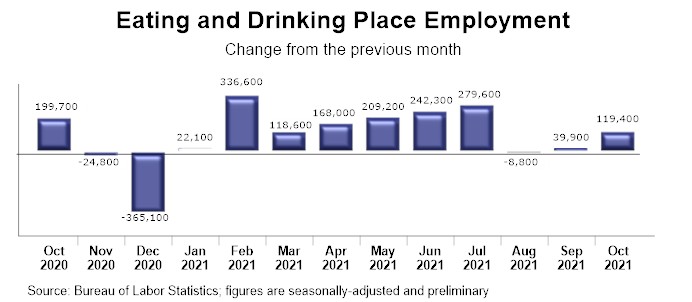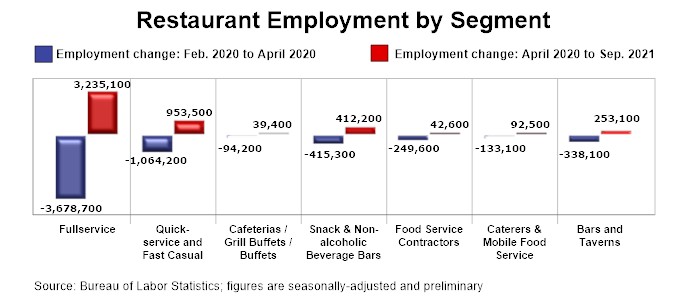Restaurant job growth improved in October
Although restaurant industry job growth improved in October, it remained well below the solid gains registered during the first 7 months of 2021. Eating and drinking places* added a net 119,400 jobs in October on a seasonally-adjusted basis, according to preliminary data from the Bureau of Labor Statistics.
That was nearly four times more jobs than the net payroll growth of just 31,000 in August and September combined. However, it still fell short of the average monthly increase of nearly 200,000 jobs during the first 7 months of the year.
As of October 2021, eating and drinking places remained nearly 800,000 jobs – or 6.4% – below their February 2020 pre-pandemic employment peak.

Limited-service segment is approaching pre-pandemic staffing levels
Although employment trended higher across all restaurant categories during the first 9 months of 2021, none of the major segments can boast a full return to pre-pandemic staffing levels. [Note that the segment-level employment figures are lagged by one month, so September is the most current data available.]
Between April 2020 and September 2021, fullservice restaurants added more than 3.2 million jobs on a seasonally-adjusted basis. However, that still left the segment 444,000 jobs (or 7.8%) below pre-pandemic employment levels.
Staffing levels in the limited-service segment are much closer to their pre-pandemic peaks. As of September 2021, the quickservice and fast casual segments were down 111,000 jobs (or 2.4%) from pre-pandemic levels. Staffing levels at snack and nonalcoholic beverage bars – including coffee, donut and ice cream shops – were only 3,000 jobs (or 0.4%) below February 2020 readings.
Other segments have a much longer road to reach pre-pandemic staffing levels. Employment counts in the cafeterias/grill buffets/buffets segment (-50.8%), foodservice contractor segment (-39.4%), bars and taverns segment (-20.1%) and catering and mobile foodservice segment (-19.1%) are still significantly below their February 2020 levels.

*Eating and drinking places are the primary component of the total restaurant and foodservice industry, which prior to the coronavirus outbreak employed 12 million out of the total restaurant and foodservice workforce of 15.6 million.
Read more analysis and commentary from the Association's chief economist Bruce Grindy.